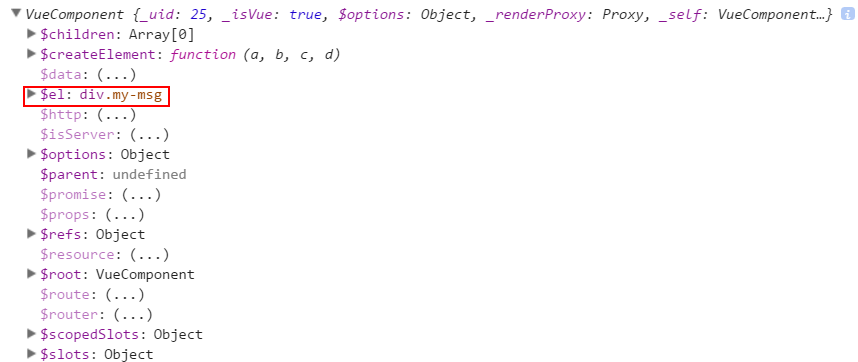学习了Vue全家桶和一些UI基本够用了,但是用元素的方式使用组件还是不够灵活,比如我们需要通过js代码直接调用组件,而不是每次在页面上通过属性去控制组件的表现。下面讲一下如何定义动态组件。
Vue.extend
思路就是拿到组件的构造函数,这样我们就可以new了。而Vue.extend可以做到:https://cn.vuejs.org/v2/api/#Vue-extend
// 创建构造器 var Profile = Vue.extend({ template: '<p>{{firstName}} {{lastName}} aka {{alias}}</p>', data: function () { return { firstName: 'Walter', lastName: 'White', alias: 'Heisenberg' } } }) // 创建 Profile 实例,并挂载到一个元素上。 new Profile().$mount('#mount-point')
官方提供了这个示例,我们进行一下改造,做一个简单的消息提示框。
动态组件实现
创建一个vue文件。widgets/alert/src/main.vue
<template> <transition name="el-message-fade"> <div v-show="visible" class="my-msg">{{message}}</div> </transition> </template> <script > export default{ data(){ return{ message:'', visible:true } }, methods:{ close(){ setTimeout(()=>{ this.visible = false; },2000) }, }, mounted() { this.close(); } } </script>
这是我们组件的构成。如果是第一节中,我们可以把他放到components对象中就可以用了,但是这儿我们要通过构造函数去创建它。再创建一个widgets/alert/src/main.js
import Vue from 'vue'; let MyMsgConstructor = Vue.extend(require('./main.vue')); let instance; var MyMsg=function(msg){ instance= new MyMsgConstructor({ data:{ message:msg }}) //如果 Vue 实例在实例化时没有收到 el 选项,则它处于“未挂载”状态,没有关联的 DOM 元素。可以使用 vm.$mount() 手动地挂载一个未挂载的实例。 instance.$mount(); document.body.appendChild(instance.$el) return instance; } export default MyMsg;
require('./main.vue')返回的是一个组件初始对象,对应Vue.extend( options )中的options,这个地方等价于下面的代码:
import alert from './main.vue'
let MyMsgConstructor = Vue.extend(alert);
而MyMsgConstructor如下。

参考源码中的this._init,会对参数进行合并,再按照生命周期运行:
Vue.prototype._init = function (options) { ...// merge options if (options && options._isComponent) { // optimize internal component instantiation // since dynamic options merging is pretty slow, and none of the // internal component options needs special treatment. initInternalComponent(vm, options); } else { vm.$options = mergeOptions( resolveConstructorOptions(vm.constructor), options || {}, vm ); } // expose real self vm._self = vm; initLifecycle(vm); initEvents(vm); initRender(vm); callHook(vm, 'beforeCreate'); initInjections(vm); // resolve injections before data/props initState(vm); initProvide(vm); // resolve provide after data/props callHook(vm, 'created'); ... if (vm.$options.el) { vm.$mount(vm.$options.el); } };
而调用$mount()是为了获得一个挂载实例。这个示例就是instance.$el。

可以在构造方法中传入el对象(注意上面源码中的mark部分,也是进行了挂载vm.$mount(vm.$options.el),但是如果你没有传入el,new之后不会有$el对象的,就需要手动调用$mount()。这个方法可以直接传入元素id。
instance= new MessageConstructor({ el:".leftlist", data:{ message:msg }})
这个el不能直接写在vue文件中,会报错。接下来我们可以简单粗暴的将其设置为Vue对象。
调用
在main.js引入我们的组件:
//.. import VueResource from 'vue-resource' import MyMsg from './widgets/alert/src/main.js'; //.. //Vue.component("MyMsg", MyMsg); Vue.prototype.$mymsg = MyMsg;
然后在页面上测试一下:
<el-button type="primary" @click='test'>主要按钮</el-button> //..
methods:{
test(){
this.$mymsg("hello vue");
}
}

这样就实现了基本的传参。最好是在close方法中移除元素:
close(){ setTimeout(()=>{ this.visible = false; this.$el.parentNode.removeChild(this.$el); },2000) },
回调处理
回调和传参大同小异,可以直接在构造函数中传入。先修改下main.vue中的close方法:
export default{ data(){ return{ message:'', visible:true } }, methods:{ close(){ setTimeout(()=>{ this.visible = false; this.$el.parentNode.removeChild(this.$el); if (typeof this.onClose === 'function') { this.onClose(this); } },2000) }, }, mounted() { this.close(); } }
如果存在onClose方法就执行这个回调。而在初始状态并没有这个方法。然后在main.js中可以传入
var MyMsg=function(msg,callback){ instance= new MyMsgConstructor({ data:{ message:msg }, methods:{ onClose:callback } })
这里的参数和原始参数是合并的关系,而不是覆盖。这个时候再调用的地方修改下,就可以执行回调了。
test(){ this.$mymsg("hello vue",()=>{ console.log("closed..") }); },
你可以直接重写close方法,但这样不推荐,因为可能搞乱之前的逻辑且可能存在重复的编码。现在就灵活多了。
统一管理
如果随着自定义动态组件的增加,在main.js中逐个添加就显得很繁琐。所以这里我们可以让widgets提供一个统一的出口,日后也方便复用。在widgets下新建一个index.js
import MyMsg from './alert/src/main.js'; const components = [MyMsg]; let install =function(Vue){ components.map(component => { Vue.component(component.name, component); }); Vue.prototype.$mymsg = MyMsg; } if (typeof window !== 'undefined' && window.Vue) { install(window.Vue); }; export default { install }
在这里将所有自定义的组件通过Vue.component注册。最后export一个install方法就可以了。因为接下来要使用Vue.use。
安装 Vue.js 插件。如果插件是一个对象,必须提供
install方法。如果插件是一个函数,它会被作为 install 方法。install 方法将被作为 Vue 的参数调用。
也就是把所有的组件当插件提供:在main.js中加入下面的代码即可。
... import VueResource from 'vue-resource' import Widgets from './Widgets/index.js' ... Vue.use(Widgets)
这样就很简洁了。
小结: 通过Vue.extend和Vue.use的使用,我们自定义的组件更具有灵活性,而且结构很简明,基于此我们可以构建自己的UI库。以上来自于对Element源码的学习。
widgets部分源码:http://files.cnblogs.com/files/stoneniqiu/widgets.zip